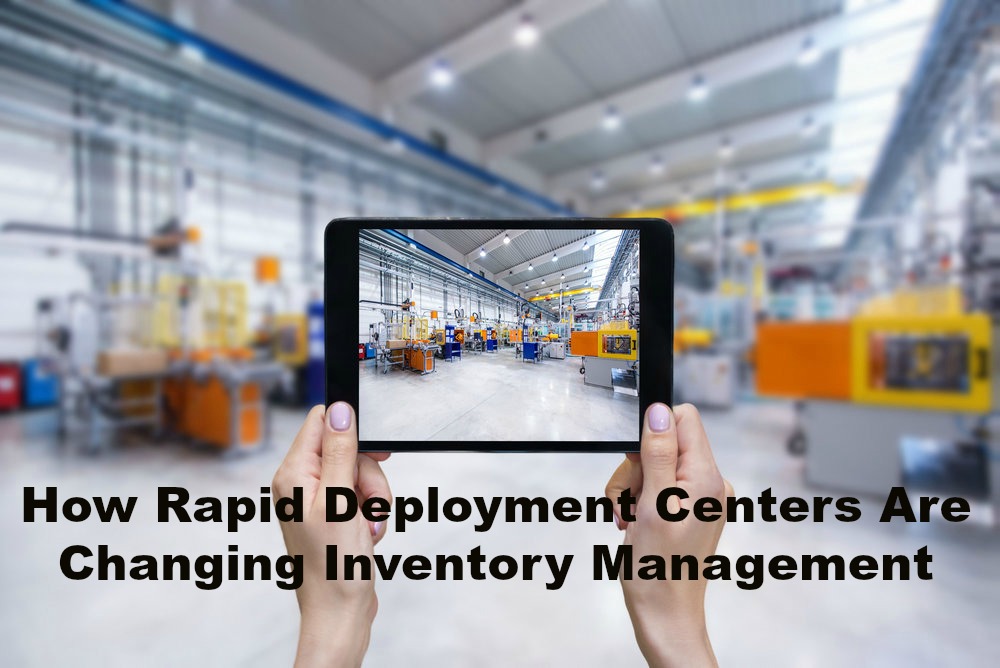Wasp Barcode Technologies: The Barcode Solution People
How Rapid Deployment Centers Are Changing Inventory Management

In the retail space, online sales brought in $97.3 billion for the second quarter of 2016. That is an increase of 4.5 percent from Q1 2016 and represents around 8 percent of the $1.2 trillion in total Q2 retail sales,
according to the U.S. Department of Commerce. That 4.5 percent uptick in online sales compares to a mere 1.5 percent increase from Q1 2016 in total retail sales. So while the overwhelming majority of sales still happen in-store, the boom in online sales is having a drastic effect on deployment centers making managing inventory an important part of the sales process.
[Tweet "Online sales brought in $97.3 billion for the second quarter of 2016."]
As e-commerce grows, it is changing the way shoppers act and what they expect. It also
increasingly changes the way that retailers operate. Catering to the demands of customers who want fast delivery around the country can put strain on organizations and their
inventory management and now it is literally reshaping the U.S. landscape as companies are building massive, rapid distribution centers in many of the country’s inland-port markets.

According to a
recent report from CBRE, the rapid growth of e-commerce has resulted in the development of new warehouses and distribution centers in the 12 main U.S. inland-port markets at almost twice the national rate. Even as real estate developers rush to construct the industrial buildings needed for these centers, demand has risen so much that 9 of these 12 markets are seeing their availability rates drop faster from their post-recession peaks than the national rate.
“Inland ports account for more than half of the fastest growing industrial markets in the U.S. because they are key way stations in the national e-commerce distribution network,” said David Egan, CBRE’s Head of Industrial & Logistics Research in the Americas. “As online commerce continues to expand, more shippers, retailers and logistics firms will seek top-quality, big-box warehouses in the leading inland-port markets to serve as critical links in their supply chains.”
[su_divider top="no" size="2"]
[su_divider top="no" size="2"]
One such market is in Lehigh Valley, Pennsylvania, where FedEx Ground is building new massive warehouse and shipping facilities, including an 800,000-square-foot automated distribution center. The center is designed to service the northeast and NY metropolitan area.
“It’s a recognition of the way e-commerce is playing a role. It’s going to make it easy for a lot of big shippers to bring big volume to them at that hub, so they can support next-day and two-day delivery as well,” Satish Jindel, a Pittsburgh-based shipping consultant who worked on FedEx’s ground network development,
explained in a recent interview. “If they don’t expand their networks, they’ll lose out on the growth of e-commerce.”
With the growth of e-commerce and these new rapid distribution centers, companies that are investing and positioning themselves for the new omni-channel reality are finally starting to see returns on that investment. “Retailers that move products in large volumes and which have invested in e-commerce infrastructure now are seeing their investments “fully in action,” Burt White, vice president of industry supply chains at consulting firm Chainalytics,
explained to the Wall Street Journal.
However, investing in infrastructure and technology needs to be thought out and effective or it can have disastrous consequences. For example, when Finish Line Inc. tried to install new infrastructure to fill online orders its new warehouse-management system didn’t work well with its old back-office systems and as a result couldn’t process orders fast enough. These missteps caused the company to lose $32 million in sales during the busy holiday season,
according to the company.
The cautionary tale highlights how important it is for retailers to get inventory management right in today’s increasingly complex omni-channel market and the need to implement strategies and approaches and inventory management software that can
work with old systems and grow with new ones.
Essentially, for retailers the new market reality means they need to be able to track inventory through every stage of the supply chain and to understand where it is and where it needs to be. The new multi-channel demands also mean that retailers need to be comfortable and capable of managing inventory across many different locations, some of which may not be under the retailers direct control. Meeting these new demands requires an understanding of how rapid deployment centers are changing supply chain and inventory management.

Supply Chain to Supply Web
The new omnichannel retail experience means retailers no longer work in a straight line supply chain. Cara Wang, a civil-engineering professor at Rensselaer Polytechnic Institute has described the new supply chain as being closer to a spider web, where inventory may be stored at multiple locations to reach the largest potential customer base.
With inventory in so many different places, retailers need to be able to gather data quickly and update it in real-time.
Barcode scanners and inventory management software make it easy to collect data without human error and immediately update your inventory database so that you always know where your inventory is. In the supply web, a manual based system,
like Excel, simply won’t work.
Increased Infrastructure Development
Beyond the geographic spread, the rise of new shipping and logistics patterns means you might not be keeping all of your inventory in your control. You might be leaving some of it in one of FedEx Ground’s automated shipping centers or at a warehouse operated by a third-party. At this point it is critical that your inventory can “play well” with others. This requires an inventory management system that can work with other organizations or machines. Barcodes are already an industry standard and
using a barcode based inventory management system makes it easy to keep track of your inventory wherever it is and for whoever is managing it.
Forecasting at the Forefront
With more inventory in more places, and more infrastructure to monitor it, the name of the game for retailers trying to maximize margins is increasing efficiency and this means
forecasting effectively. Inventory management systems that are going to succeed in the long-term need to be able to predict potential future needs and create reports that can help business leaders decide how and where to allocate resources.
Inventory management systems that use barcodes and a central, shareable database that is updated in real-time,
like System ID’s inventory management solutions, are one way to ensure that you monitor your inventory throughout the supply chain and make it easy for employees and partner organizations to find and work with your inventory. They also can provide you with the forecasting tools you need to make sure you have enough inventory in the right places at the right time.





